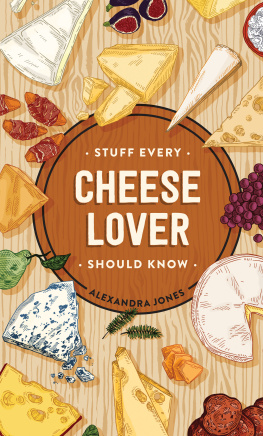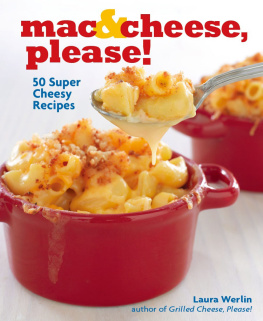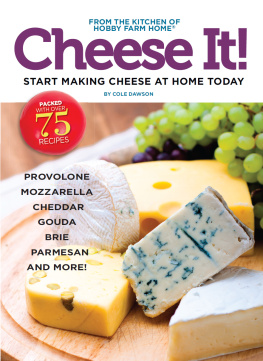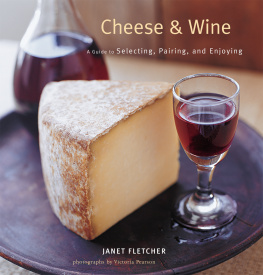This book never would have been written without the trust, encouragement, and absolutely stunning support from everyone at Di Bruno Bros. I cant imagine a kinder or more passionate group of people. Huge thanks to Kristen Green Wiewora at Running Press for lighting on this idea with such a vengeance and to the worlds most valiant agent, Amy Williams, for shepherding this project into the fold.
William and Emilio Mignucci at Di Bruno Bros. believed in this book from its inception, and cheesemonger Hunter Fike welcomed me behind the counter for a year of tasting and talking. His friendship and written contributions were so essential. Ezekial Ferguson, who handed me my first cheese sample six years ago, read every draft, cheered us on, and broke out the camp stove in the back of the Italian Market store to help recipe-test grilled cheese.
Special thanks to Chef Rob Sidor and everyone in the kitchen at Di Bruno Bros. on Chestnut Street for developing many of the recipes for this book. And to everyone on staff who contributed pairing ideas, suggestions, and enthusiasm, thank you: Adam Balkovic, Dan Black, Mark Bomalaski, Evan Bortzfield, Rebecca Brumberg-Frimmer, Melanie Fortino, Jamie Hoffman, Richard-Luis Morillo, Ian Peacock, Jamie Png, Rocco Rainone, Matt Shankle.
Finally, to the cheesemakers who produce the beautiful wheels described within these pages, you have my undying gratitude. For all the evenings you spend in the milk barn and all the mornings you rise to cut curd, know that you bring so much pleasure to countless delighted eaters.
The world is full of wonderful resources about cheese. The ones on this list were invaluable during the writing of this book. Many of them make excellent bedtime or kitchen table reading.
BOOKS
Beckett, Fiona. Fiona Becketts Cheese Course. London: Ryland, Peters & Small, 2009.
Chartier, Franois. Tastebuds and Molecules: The Art and Science of Food with Wine. Toronto: McClelland & Stewart Ltd., 2010.
Dalby, Andrew. Cheese: A Global History. London: Reaktion Books, 2009.
Davies, Sasha. The West Coast Guide to Cheese. Portland: Timber Press, 2010.
Dorenburg, Andrew, and Karen Page. What to Drink with What You Eat. New York: Bulfinch Press, 2006.
Fletcher, Janet. Cheese and Wine: A Guide to Selecting, Pairing, and Enjoying. San Francisco: Chronicle Books, 2007.
Grescoe, Taras. The Devils Picnic: Travels Through the Underworld of Food and Drink. New York: Bloomsbury, 2005. (See on Epoisses.)
Harbutt, Juliet. World Cheese Book. New York: DK Publishing, 2009.
Herbst, Sharon Tylor, and Ron Herbst. The Cheese Lovers Companion: The Ultimate A-to-Z Cheese Guide. New York: William Morrow, 2007.
Jenkins, Steven. Cheese Primer. New York: Workman, 1996.
Kaufelt, Rob. The Murrays Cheese Handbook. New York: Broadway Books, 2006.
Kindstedt, Paul. Cheese and Culture. Burlington: Chelsea Green, 2012.
Linford, Jenny. Great British Cheeses. London: DK Publishing, 2008.
Masui, Kazuka, and Tomoko Yamada. French Cheese. 3rd ed. New York: DK Publishing, 2005.
McCalman, Max, and David Gibbons. Mastering Cheese: Lessons for Connoisseurship From a Matre Fromager. New York: Clarkson Potter, 2009.
McGee, Harold. On Food and Cooking. New York: Scribner, 2004.
Michelson, Patricia. The Cheese Room. London: Penguin Books, 2001.
Mogannam, Sam, and Dabney Gough. Eat Good Food. Berkeley: Ten Speed Press, 2011.
Oliver, Garrett. The Oxford Companion to Beer. Oxford: Oxford University Press, 2011.
Roberts, Jeffrey. The Atlas of American Artisan Cheese. White River Junction: Chelsea Green Publishing, 2007.
Segnit, Niki. The Flavor Thesaurus. New York: Bloomsbury, 2010.
Slow Food Foundation. Italian Cheese: A Guide to Its Discovery and Appreciation. Milan: Slow Food Editore, 2005.
Thorpe, Liz. The Cheese Chronicles. New York: Harper Collins, 2009.
Weinzweig, Ari. Zingermans Guide to Good Eating. New York: Houghton Mifflin Harcourt, 2003.
Werlin, Laura. The New American Cheese. New York: Stewart, Tabori, & Chang, 2000.
MAGAZINES
Culture
www.culturecheesemag.org
Cheese Connoisseur
www.cheeseconnoisseur.com
The Art of Eating
www.artofeating.com
WEBSITES
Cellars at Jasper Hill
www.cellarsatjasperhill.com
Cowgirl Creamerys Library of Cheese
www.cowgirlcreamery.com/library.asp
Culture Magazines Online Cheese Library
www.culturecheesemag.com/cheese-library
Cutting the Curd (podcasts by Anne Saxelby)
www.heritageradionetwork.com/program s/14-Cutting-the-Curd
Neals Yard Dairy
www.nealsyarddairy.co.uk
ORGANIZATIONS
American Cheese Society
www.cheesesociety.org
National Association for the Specialty Food Trade (NASFT)
www.specialtyfood.com
Slow Food USA
www.slowfoodusa.org
Slow Food International
www.slowfood.org
(fresh, unaged)
These young, fresh cheeses are mellow and easygoing. Theyre a great place to start if youre shy, and theyre perfect for a summer evening when garden-ripe tomatoes and peaches need bedfellows. Pop the cork on Prosecco or ros, and youre good for eating and drinking the night away.
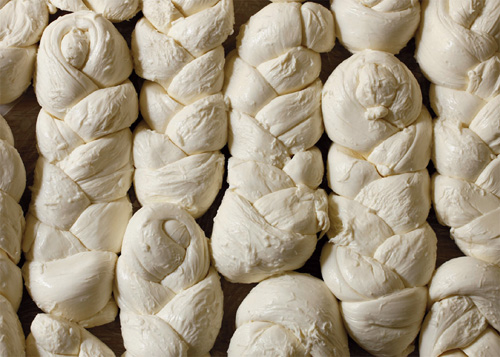
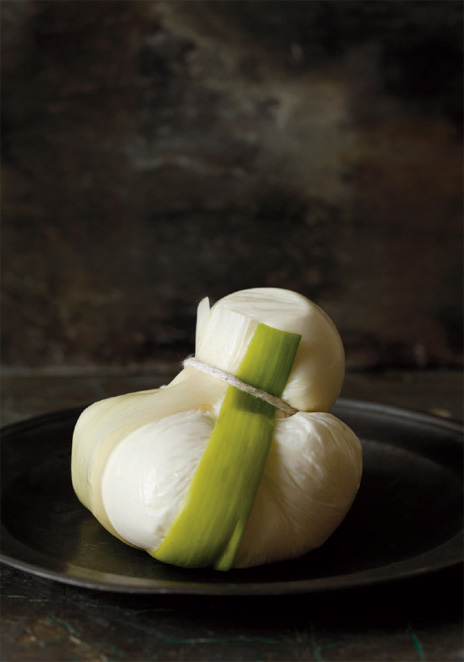
BURRATA
ITALY, COWS MILK
PERSONALITY: Mozzarella with soula rare treat with a dreamy center.
Burrata is to the cheese world what the dumpling is to Asian cuisine: the ultimate comfort food. Within each pouch of noodle-soft mozzarella is a center filled with cream and, sometimes, truffle shavings or fresh herbs. Airy and cloud-light, this fresh cheese is meant to be drizzled with olive oil, sprinkled with sea salt and black pepper, then sopped up with bread. Over the last few years, burrata (pronounced Boo-RAH-ta) has become something of a dairy darling, especially in restaurants. Along the East Coast, youre likely to find it on summer menus served with heirloom tomatoes; on the West Coast, with sea urchin.
Di Bruno Bros. has made burrata in house for decades. Its tied off with leek leaves and kitchen twine, just as custom dictates in Puglia, where this cheese originates. The twine holds the pouch together, and the leeks are used to help gauge freshness. Buy burrata when the leaves are emerald bright; when the leaves turn spotty or brown, toss the burrata out. Great burrata is plush, luxuriant, and coolinga gentle balm after a sun-drenched day at the beach.
Good matches: To serve, set your burrata on a lipped plate, remove the leaves, and cut the cheese in half, vertically. Drag hunks of baguette through the cream and serve them to your beloved, preferably in a hammock.
Wine/beer: Pick up something sparkly, unless youre serving antipasti, in which case you can ramp up to a spicy red or something fruity and supple. Young Chianti or Barbera work well with fresh cheeses. So does an icy cold Pilsner.
THE HUMBLE BEGINNINGS OF BURRATA
History is riddled with proud, noble cheeses that have had their names slandered by massproduced knock-offs. Weve all seen them, pre-shredded, canned, or cryovac-ed, populating the dairy aisle of your local grocery store; Cheddars, Parmesan, and Swiss that bear little resemblance to their handmade originals.


